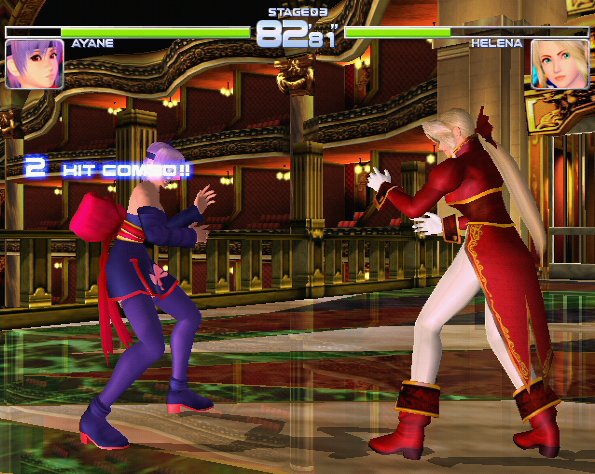
It’s finally here. The game that many believed would be the first serious challenger to Soul Calibur for the title of “Best Dreamcast 3D fighter” has finally hit store shelves. Is it the next gigantic hit for the Dreamcast or is this a case of a game that couldn’t possibly live up to the hype? The answer falls somewhere in the middle.
The graphics most certainly live up to the hype. Undoubtedly, Dead or Alive 2 is one of the most attractive console games ever produced. Everything that appears onscreen has been rendered with a fine attention to detail. From flags blowing in a light breeze to the fringe on Tina’s armbands, everything moves realistically. The female fighters’ breasts, which were beyond gelatinous in the original Dead or Alive, have returned to a much more realistic firmness. (Hey, I had to mention that sooner or later, so it might as well have been sooner.) The fighters even react to getting hit in a realistic manner. Punch an opponent in the stomach and he or she will double over as if they’ve had the wind knocked out of them. Hit an opponent in the face with an uppercut and he or she will bend backward, reeling in pain. It’s very gratifying to see your opponents wincing every so often, rather than simply standing there waiting for the next punch or kick.
Dead or Alive 2 differs from Soul Calibur in that there are no weapons used in combat. There are also no magic powers or fireballs either. This is strictly hand-to-hand warfare. While the game isn’t exactly a fighting simulation, it retains more realistic qualities than your average fighter. Each button on the Dreamcast controller is used during battle. The “X” button is punch. The “Y” button is kick. The “A” button is the “free move” button and the “B” button is used for throws. You’re able to move freely about the fighting area by using the “free” button or by using the analog stick. The free button can also be used while countering moves and for certain holds.
The actual fighting is based on series of moves and countermoves that enable opponents to turn things around on each other fairly easily. There are no “ring outs” in the game either. If you’re fighting on a ledge and you throw your opponent off, the fight isn’t over. You’ll jump down after your challenger and continue the beating. Many multi-level fighting areas are available in this game, including a Cathedral, an Opera House and a Japanese Garden.
There are 12 fighters to choose from and each has a different fighting style. For example, Jann Lee fights in the Jeet Kune Do style invented by Bruce Lee. Ryu uses ninjitsu. Bass and Tina Armstrong are professional wrestlers, so they have a few holds and throws you might see during “RAW is WAR” on Monday night. The differing styles mean that each opponent has to be approached with a different strategy. What works against one opponent will not work against all of them.
There are several different modes of play in Dead or Alive 2. The main single player attraction is Story Mode. This allows the player to fight seven fighters before reaching Evil Tengu, the main boss of the game. The “story” is not exactly full of character development, but the movies that connect each battle are interesting enough to keep things moving along. One very nice feature is that there’s no waiting between the end of the cinematic sequence and the beginning of the actual fight. They blend seamlessly together.
Other modes include: Survival Mode, which pits a single player against opponents until his or her health runs out; Time Attack Mode, which asks the player to fight through eight opponents as fast as possible; and Tag Team Mode, which allows the player to pick two fighters and pit them against two other fighters, with the ability to switch the fighter you’re controlling at any time in the fight. There’s also the Tag Battle, a contest which allows four players to play simultaneously, working together in teams.
One problem with Dead or Alive 2 is that there is little in the way of secrets to unlock or enticements to keep a single player’s attention much beyond the first few days of owning the title. Beating the Story Mode does not unlock new fighters or new costumes for the existing fighters. Beating the Tag Team Mode doesn’t open new fighting arenas in which to battle. Everything seems to be available the first time you play. While the additional options of Survival Mode, Time Attack Mode, and Tag Battle do help add quite a bit of replay-ability to the game, the lack of a true mission mode, a la Soul Calibur, is sorely missed.
Dead or Alive 2 is one of the best fighting games to come down the pike in a long time. The strategic aspect of the “moves vs. countermoves” style of play, along with the differing styles of the fighters, adds true challenge to the game. The game maintains a nice balance between being easy to learn and being too simplistic for the hardcore fighter. The only fly in the ointment is the lack of a mission-oriented single player mode and that’s a minor omission in the face of the fantastic game-play.
Dead or Alive 2 is a definite must-buy for the fighting game fan.
9.5 out of 10.

